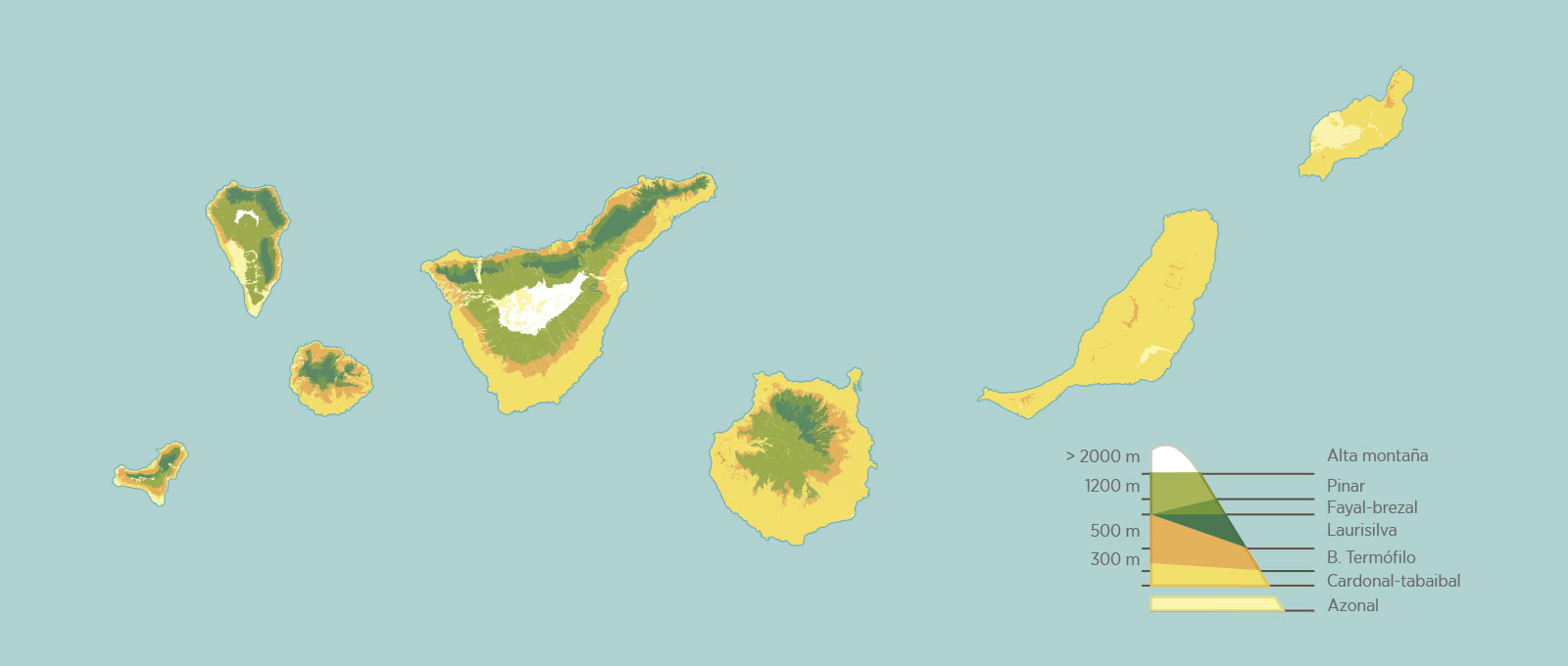Trees and woods
THE CANARY ISLANDS: A PARADIGM OF BIODIVERSITY
The Canary archipelago, comprising seven islands and six islets, occupies a total of 7500 km2 and is home to a wide variety of ecosystems, enormous biological richness and unique geological formations. Thanks to its geographical location, the Canaries has a subtropical climate moderated by the trade winds and thermoregulated by the Atlantic Ocean. Factors including altitude (with clear variations in temperature, precipitation, humidity and insolation, according to level), orientation (with marked differences between the north-and south-facing aspects of the islands), and the brusque island relief, mean that there are many different microclimates.
This circumstance, together with the various volcanic soils, has given rise to a remarkable wealth of ecosystems and an exceptionally rich and diverse natural world. Even at first glance, it is easy to appreciate this ecological diversity by observing the extraordinary contrasts in the natural landscapes of the islands.
On the other hand, despite their proximity to Africa (95 km away), the Canary Islands have maintained a certain degree of isolation that, together with the climatic and topographic characteristics mentioned, has favoured the appearance of a great number of endemic species.
VEGETATION LEVELS
The terrestrial ecosystems on the Canary Islands are grouped into communities that are divided int0 different levels or strips.
Project TSP (IECI-EFC) · CC-BY-NC-SA
COASTAL SCRUB AND CARDONAL-TABAIBAL (PISO BASAL LOWLANDS)
This first level of vegetation occupies the lowest slopes on all the islands, from sea level to an altitude of 350 m, and is influenced by its proximity to the sea. The species that develop here are adapted to infrequent precipitation, high temperatures throughout the year, a high degree of insolation and very poor soils. The piso basal lowlands are dominated by halophytic vegetation, which is able to grow in salt-rich environments, and psammophylic plants, which are adapted to sandy substrates, like the tamarisks (Tamarix). Outside the direct influence of the sea, is the important cardonal-tabaibal formation, comprising succulents, and one of the most typical of the Canaries. Here the most common species are the Canary Island spurge (Euphorbia canariensis) and various other plants from the genus Euphorbia (E. balsamifera, E. regis-jubae, etc.), that can be found together with the verode (Kleinia neriifolia), Ceropegia fusca, Plocama pendula, and Launaea arborescens.
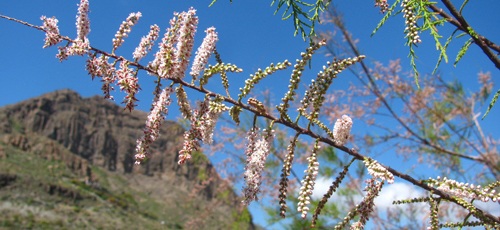

THERMOPHILOUS FOREST (TRANSITION LEVEL)
The next level up is located more or less between altitudes of 350 and 600 m on both northern and southern slopes. This strip is also characterised by little precipitation, but the temperatures are slightly milder and the soil is richer. The thermophilous forest, which is very similar to Mediterranean forest, is part of the transition level. Nevertheless, this formation is almost absent on some islands and in a somewhat precarious situation on the others. In fact, the thermophilous forest is not a homogenous community, but comprises a mosaic of formations named after the locally dominant tree species: sabinares (juniper: Juniperus turbinata subsp. canariensis), almacigares (Mount Atlas mastic: Pistacia atlantica), lentiscales (mastic: Pistacia lentiscus), acebuchales (olive: Olea cerasiformis) and palmerales (Canary Island date palm: Phoenix canariensis). Currently almost non-existent in a natural form, the dragonales (dragon trees: Draco dracaena and D. tamaranae) also used to be components of these forests. Other species comprising these woodlands are Sideroxylon canariensis, Maytenus canariensis and Visnea mocanera. Unfortunately, this forest is in a very deteriorated state, and has suffered an important loss of habitat due to the influence of humans: this level represents some of the most important farmland, as well as being the most densely populated.
MONTEVERDE: LAUREL FOREST AND MORELLA-ERICA HEATH (MONTANE LEVEL)
Above altitudes of 600 m up to 1200-1500 m is the montane level, where the Monteverde forest develops. This formation, characterised by a huge diversity of arboreal species, can be found on all the islands with the exception of Lanzarote, as that island does not reach a sufficient height above sea level. Its natural distribution is principally defined by the influence of the trade winds on the northern slopes of the most mountainous islands, which give rise to the ‘sea of clouds’. This cloud bank is responsible for the so-called ‘horizontal rain’ or ‘fog precipitation’, that provides humidity and water resources to the vegetation, and which adds to the direct annual precipitation. In some southern basins, occasional overflows from the sea of clouds also enable this plant formation to survive. Monteverde soils are particularly deep, acidic, with abundant humus, and normally nitrogen-rich. They tend to be covered by a thick layer of decomposing organic matter, containing a lot of plant remains (e.g., fallen trunks, dry branches, and leaf litter). The Monteverde forest includes two woodland formations: the laurel forest, known locally as the laurisilva, and the Morella-Eric heath, or fayal-brezal.
The laurel forest is probably one of the most well-known arboreal formations in the Canaries, and is considered a true living fossil. It is characteristic of northern zones and regions influenced by the mists generated by the trade winds. It is a subtropical humid forest composed of many shade trees, i.e., with wide leaves that create cover and allow little light to reach the forest floor (ombrophilic forest). The most common trees are the laurel (Laurus novocanariensis), the Canary laurel (Apollonias barbujana), species of holly (Ilex canariensis and Ilex perado), Persea indica, Rhamnus glandulosa, Picconia excelsa and Viburnum tinus subsp. rigidum. The rarest include Heberdenia excelsa, the stinkwood (Ocotea foetens), the Canary spurge (Euphorbia mellifera), Pleiomeris canariensis, Arbutus canariensis, Sambucus palmensis, and the Portugal laurel (Prunus lusitanica). In general, the laurel forest develops on deep soils.
The Morella-Erica heath is either a laurel forest substitution formation that occurs in areas degraded by repeated logging, or a natural transition to the pine forests. It is a forest characterised by abundant tree heaths (Erica arborea), firetrees (Morella faya), and, to a lesser extent, the heather Erica platycodon subsp. platycodon, which are typical of the most humid summit zones on Tenerife and La Gomera. It can occasionally be accompanied by the small-leaved holly (Ilex canariensis) or laurel (Laurus novocanariensis). For this reason it is a poorer formation than the laurel forest. Some plants in the Morella-Erica heath can become so large and the vegetation so closed that they make it difficult for other species to become established, as happens in some stands on El Hierro.
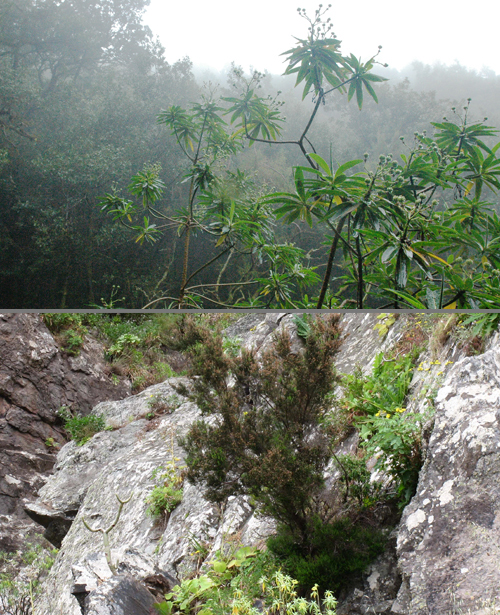
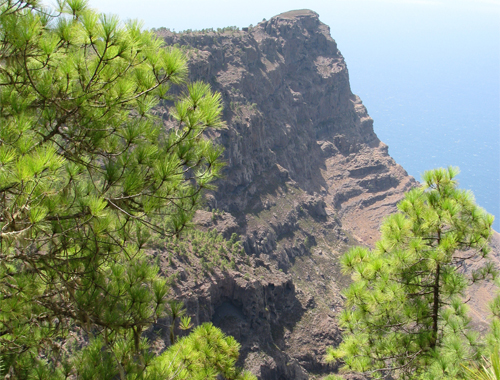
THE CANARY ISLAND PINE GOVES (MONTANE LEVEL)
The pine forest is a formation dominated by the Canary Island pine (Pinus canariensis) and, generally, has rather poor underbrush. It is found above altitudes of 1300-1500 m on the north-facing slopes of the islands, or 500-600 m on the southern slopes, under the influence of dry winds (low humidity), and can be as high as 2000-2300 m above sea level. The Canary Island pine produces the most extensive forests in the archipelago: on the most mountainous islands (Tenerife, La Palma, Gran Canaria) it forms a crown around the summits. It is also an important species on El Hierro, although this pine only appears occasionally on La Gomera. This formation adapts well to adverse conditions (soils that are acidic, highly eroded, stony, etc.) and grows in zones with very different climates, as it tolerates both high and low temperatures (including frosts), as well as either scarce or abundant precipitation. These differences are so evident that they have resulted in at least three types of pine forests, depending on the environmental conditions. The first is the humid pine zone, found in regions influenced by the trade winds on the north- and northeast-facing slopes of the islands, above the Monteverde forest. This is a very well-developed forest, very thick and includes many old pines. The dry pine zone is more open than the humid pine and represents the largest wooded expanse in the archipelago, as it is situated on the southern slopes above the thermophilous forests. The significant regression of the thermophilous forest in the south is, possibly, the reason this pine formation begins at lower levels than would potentially correspond to this woodland. Lastly, is the summit pine zone, located at the highest levels, above altitudes of 1800 m, and which is therefore exposed to a great deal of insolation and strong winds. The flora of this pine forest is enriched by high-mountain species such as the Canary Islands juniper (Juniperus cedrus) and the tagaste (Chamaecytisus proliferus).
SUMMIT SCRUB (HIGH MOUNTAIN LEVEL)
This scrub is only present on the islands above 2000 m high, i.e., Tenerife and La Palma, and is composed of species adapted to abrupt changes in temperature, strong insolation, intense winds, and even heavy snow, many of which are endemic. The most important arboreal species in this zone is the Canary Islands juniper (Juniperus cedrus).

HUMAN INFLUENCE
In addition to natural conditions, humans also modify the landscape as they exploit forest resources and occupy the land. On the Canary Islands, the lowland piso basal vegetation, including the coastal scrub and particularly the ‘cardonal-tabaibal’ formation, are most impacted by urban development and tourism. In this strip, the majority of the naturally-occurring species have been displaced, and frequently replaced by commercial fruit trees (e.g., bananas) or greenhouse crops (particularly tomatoes). In addition, the abandonment of cattle pasture, also caused by tourism-related activities, has resulted in the proliferation of opportunistic secondary species. Moreover, the strip of land comprising the Monteverde zone is extensively exploited for agriculture and is home to numerous rural settlements.
This has all contributed to the chronic degradation of the vegetation. To help counteract or mitigate this human impact, 40% of the Canarian territory is part of the Canarian Network of Protected Natural Spaces (involving 146 individual spaces) and policies are being promoted to recover the natural environment through repopulation and reintroduction. Nevertheless, the recovery of zones altered by human influence does not necessarily mean returning to the original state, but can include evolution towards other structures or different plant equilibriums. For example, sloping land suffers a great deal from the loss of its tree cover; the progressive erosion of the soil may prevent the previously dominant tree from re-establishing, favouring colonisation by another species better adapted to the features of the new terrain.
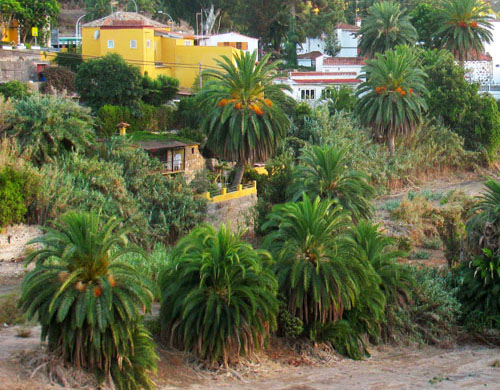
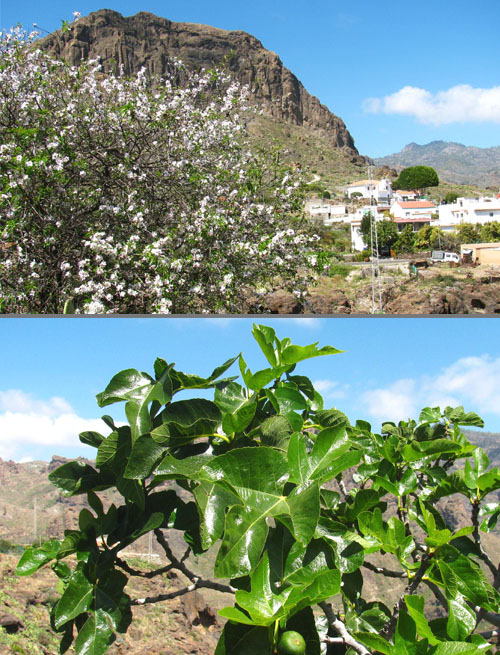
NON-NATIVE TREES
The wild trees currently found in the Canaries can be divided into native and non-native (allochthonous) species. Native trees represent the primitive island vegetation and many are of incalculable scientific value, since they are the remains of trees that lived in southern Europe and North Africa more than 20 million years ago. Non-natives are introduced species that, when becoming established in the wild, have occupied the ecological niche of native species, in some cases coexisting with them and in others displacing them (invasive species).
Some trees have been planted for fruit production, like oranges (Citrus aurantium), mulberries (Morus), plums (Prunus domestica), almonds (Prunus dulcis) and loquats (Eriobotrya japonica). These trees include the fig (Ficus carica), which is thought to have been introduced by the Canarian natives, and the sweet chestnut (Castanea sativa), which is widely distributed and can comprise almost entire woodlands in humid zones of the montane level where the soils are sufficiently well developed. Many animals have contributed to the spread of these trees by consuming their fruit and dispersing the seeds.
Many other trees have been imported for their ornamental value. This is true of many found in urban and landscaped areas. Among these are the Chinese banyan (Ficus microcarpa), jacaranda (Jacaranda mimosifolia), magnolia (Magnolia grandiflora), cypresses (Cupressus sempervirens and C. macrocarpa), and the tree of heaven (Ailanthus altissima). Sometimes some species ‘jump’ from cultivated areas, forming stands on abandoned land, in open fields, ditches and roadsides, like the chinaberry tree (Melia azedarach), the London plane (Platanus hispanica), some tamarisks (gen. Tamarix), the black locust (Robinia pseudoacacia), the thorny locust (Gleditsia triacanthos), the Peruvian pepper (Schinus molle), and the Jerusalem thorn (Parkinsonia aculeata). Some of these ornamental trees have adapted so well to the environmental conditions on the Canary Islands that they have become very aggressive towards the local flora (invasive species), like the sweet pittosporum (Pittosporum undulatum) and the acacias (gen. Acacia). Often, species were chosen for reforesting based exclusively on their lumber potential, which is why some of them have proven inadequate for regenerating or maintaining the original ecosystems. This is the case of the eucalyptus (gen. Eucalyptus) and some foreign pines (gen. Pinus), that now form fairly important stands.
On the other hand, willows (Salix fragilis), which are associated with riverbanks and water courses, were planted mainly for their use in basket making. Certain species of eucalyptus (gen. Eucalyptus), mulberries (gen. Morus), holm oaks, English oaks and cork oaks (gen. Quercus) have benefited from plantations set up for commercial purposes or domestic use. These plants have spread from the areas forested with them and colonised other environments.
THE BENEFITS WE GET FROM THE TREES
The benefits we get from trees are numerous: they produce oxygen, purify the environment by filtering out impurities and heavy metals, control erosion by stabilising the substrate with their roots, limit the impact of rain against the soil, aid water filtration by moving it down more slowly, facilitate precipitation by retaining environmental and soil humidity, moderate the temperature as their presence diminishes abrupt changes in cold and heat. Additionally, they are extremely important as producers of wood, charcoal, paper pulp, resins, flowers and fruit, and as tanning and dyeing agents and ornamental plants.
As well as botanical information, Arbolapp includes literary quotes, refrains, curiosities, anecdotes, and references to the etymology of the trees and their uses. With this broad perspective, we hope that when a user finds themselves in front of a tree, they can better interpret the landscape surrounding, reading its leaves, bark, flowers and fruits, and learning about its form, shape and age.

